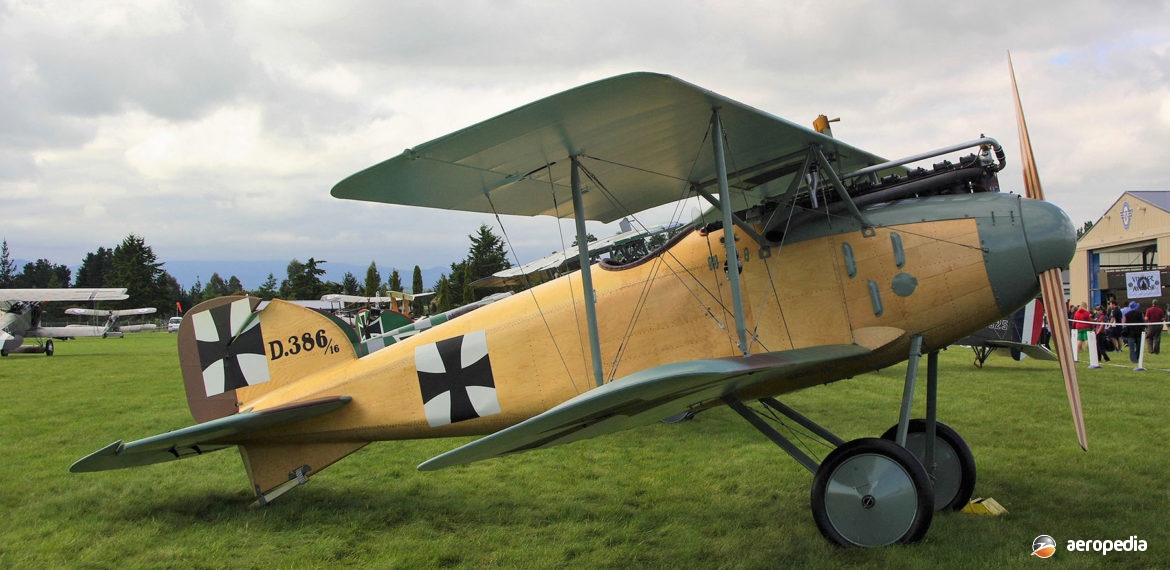Photograph:
Albatros D.II reproduction ZK-JNB (c/n 094) at Masterton, New Zealand in 2013 (David C Eyre)
Country of origin:
Germany
Description:
Single-seat fighter scout
Power Plant:
One 119 kw (160 hp) Mercedes D.III six-cylinder in-line liquid-cooled engine
Specifications:
- Wingspan: 8.5 m (27 ft 9 in)
- Length: 7.4 m (24 ft 3 in)
- Height: 2.64 m (8 ft 7 in)
- Wing area: 24.9 m² (268.03 sq ft)
- Max speed at sea level: 175 km/h (108 mph)
- Cruising speed at 3,000 m (9,843 ft): 139 km/h (86 mph)
- Service ceiling: 5,200 m (17,060 ft)
- Time to climb to 1,000 m (3,281 ft): 4 mins 27 secs
- Time to climb to 4,000 m (13,123 ft): 30 mins
- Endurance combat: 1 hr 20 mins
- Endurance at 1,000 m (3,281 ft): 2 hrs 50 mins
- Fuel capacity: 85 litres (18.7 Imp gals)
- Empty weight: 673 kg (1,484 lb)
- Loaded weight: 898 kg (1,980 lb)
Armament:
Two 7.92 mm (0.312 in) IMG 08 or LMG 08/15 fixed forward firing synchronised machine guns
History:
The Albatros D.II was designed by Messrs Thelen, Schubert and Gnadic for Albatros Flugzeugwerke following complaints by fighter pilots relating to the poor upward vision available in the Albatros D.I. To solve this problem, the upper wing was moved closer to the fuselage and was staggered forward slightly. The cabane struts were re-designed in order to improve the view also. Otherwise the D.II retained the fuselage of the D.I, as was the engine and the armament, and performance of the two models was similar. The Inspektion der Fliegertruppen, or Inspectorate of Flying Troops, initially ordered a batch of 100 aircraft in August 1916.
In November 1916 orders were made that operational aircraft should have their Windhoff radiators lowered below the level of the crankcase as damage from enemy fire could cause the cooling system to drain. Towards the end of the type’s service a Teves und Braun radiator replaced the radiator in the centre-section of the upper wing. This was still not successful and eventually in the D.III and D.V it was moved to the right of the centre section.
A number of German aces flew the D.II, including Hauptmann Oswald Boelcke of Jasta 2, and Manfred von Richthofen. The D.II was very successful and for a period won back air superiority from Allied types.
Albatros built 200 D.IIs and LVG produced a further 75 under licence. In January 1917 some 214 were in service but by June 1917 they had lost their superiority and were replaced by other types. By December 1917 only 20 examples remained at the front. It was in an Albatros D.II on 23 November 1916 that Richthofen was involved in a lengthy dogfight with Lanoe Hawker VC of the RFC in a DH.2 during which he fired 900 rounds before Hawker was shot through the head.
After the war a few examples were operated in Poland and in Turkey by the Ottoman Air Force. A total of 20 Albatros D.IIs was built for the Austro-Hungarian Air Service by Oeffag as the Series 53, these having the 138 kw (185 hp) Austro-Daimler engine.
In later years a number of replica / reproduction World War I aircraft have been built, and in Austria a D.II and a D.III have been completed. The former was imported to New Zealand, is airworthy and is flying with The Vintage Aviator at Masterton, becoming ZK-JNB (c/n 094) in April 2013.

